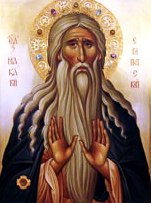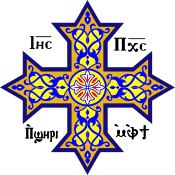
Anthony the Great was a Christian monk from Egypt, revered since his death as a saint. He is distinguished from other saints named Anthony, such as Anthony of Padua, by various epithets: Anthony of Egypt, Anthony the Abbot, Anthony of the Desert, Anthony the Anchorite, Anthony the Hermit, and Anthony of Thebes. For his importance among the Desert Fathers and to all later Christian monasticism, he is also known as the Father of All Monks. His feast day is celebrated on 17 January among the Eastern Orthodox and Catholic churches and on Tobi 22 in the Coptic calendar.

Pachomius, also known as Saint Pachomius the Great, is generally recognized as the founder of Christian cenobitic monasticism. Coptic churches celebrate his feast day on 9 May, and Eastern Orthodox and Roman Catholic churches mark his feast on 15 May or 28 May. In the Lutheran Church, he is remembered as a renewer of the church, along with his contemporary, Anthony of Egypt on 17 January.

Macarius of Egypt was a Christian monk and grazer hermit. He is also known as Macarius the Elder or Macarius the Great.

Saint Macarius of Alexandria was a monk in the Nitrian Desert. He was a slightly younger contemporary of Macarius of Egypt, and is thus also known as Macarius the Younger.

Christian monasticism is the devotional practice of Christians who live ascetic and typically cloistered lives that are dedicated to Christian worship. It began to develop early in the history of the Christian Church, modeled upon scriptural examples and ideals, including those in the Old Testament. It has come to be regulated by religious rules and, in modern times, the Canon law of the respective Christian denominations that have forms of monastic living. Those living the monastic life are known by the generic terms monks (men) and nuns (women). The word monk originated from the Greek μοναχός, itself from μόνος meaning 'alone'.

Cenobiticmonasticism is a monastic tradition that stresses community life. Often in the West the community belongs to a religious order, and the life of the cenobitic monk is regulated by a religious rule, a collection of precepts. The older style of monasticism, to live as a hermit, is called eremitic. A third form of monasticism, found primarily in Eastern Christianity, is the skete.

The Desert Fathers were early Christian hermits and ascetics, who lived primarily in the Scetes desert of the Roman province of Egypt, beginning around the third century AD. The Apophthegmata Patrum is a collection of the wisdom of some of the early desert monks and nuns, in print as Sayings of the Desert Fathers. The first Desert Father was Paul of Thebes, and the most well known was Anthony the Great, who moved to the desert in AD 270–271 and became known as both the father and founder of desert monasticism. By the time Anthony had died in AD 356, thousands of monks and nuns had been drawn to living in the desert following Anthony's example, leading his biographer, Athanasius of Alexandria, to write that "the desert had become a city." The Desert Fathers had a major influence on the development of Christianity.

A skete is a monastic community in Eastern Christianity that allows relative isolation for monks, but also allows for communal services and the safety of shared resources and protection. It is one of four types of early monastic orders, along with the eremitic, lavritic and coenobitic, that became popular during the early formation of the Christian Church.

Wadi El Natrun is a depression in northern Egypt that is located 23 m (75 ft) below sea level and 38 m (125 ft) below the Nile River level. The valley contains several alkaline lakes, natron-rich salt deposits, salt marshes and freshwater marshes.

The Monastery of Saint Macarius The Great also known as Dayr Aba Maqār is a Coptic Orthodox monastery located in Wadi El Natrun, Beheira Governorate, about 92 km (57 mi) north-west of Cairo, and off the highway between Cairo and Alexandria.

The Monastery of Saint Pishoy in Wadi El Natrun, Beheira Governorate, Egypt, is the most famous monastery of the Coptic Orthodox Church of Alexandria named after Pishoy. It is the easternmost of the four current monasteries of Wadi el Natrun.

Paromeos Monastery, also known as Baramos Monastery, is a Coptic Orthodox monastery located in Wadi El Natrun in the Nitrian Desert, Beheira Governorate, Egypt. It is the most northern among the four current monasteries of Scetis, situated around 9 km northeast of the Monastery of Saint Pishoy. Ecclesiastically, the monastery is dedicated to and named after the Virgin Mary.

Eastern Christian monasticism is the life followed by monks and nuns of the Eastern Orthodox Church, Oriental Orthodoxy, the Church of the East and Eastern Catholicism. Eastern monasticism is founded on the Rule of St Basil and is sometimes thus referred to as Basilian.

The Monastery of Saint Mary El-Sourian is a Coptic Orthodox monastery located in Wadi El Natrun in the Nitrian Desert, Beheira Governorate, Egypt. It is located about 500 meters northwest of the Monastery of Saint Pishoy.

The Monastery of Saint Anthony is a Coptic Orthodox monastery standing in an oasis in the Eastern Desert of Egypt, in the northern part of the Red Sea Governorate close to the border with the Suez Governorate.
Abraham of Farshut was an abbot and is a saint of the Coptic Church, and by extension all of the Oriental Orthodox Churches. His feast day in the calendar of saints of the Coptic Church is February 12.

Chariton the Confessor was an early Christian monk. He is venerated as a saint by both the Western and Eastern Churches. His remembrance day is September 28.
Pbow was a cenobitic monastery established by St. Pachomius in 336-337 AD. Pbow is about 100 km (62 mi) north of Luxor in modern Upper Egypt.






























